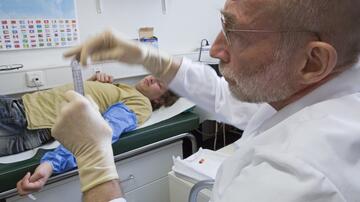New biomarker for predicting side effects of multidrug-resistant tuberculosis therapy
Treatment with Linezolid, an antibiotic that is used against multi-resistant tuberculosis bacteria, leads to adverse drug reactions in around a quarter of patients, including certain nerve disorders. These can significantly impair the quality of life of those affected, weaken adherence to therapy and thus jeopardise the success of treatment. Researchers at the Research Center Borstel, Leibniz Lung Center and the German Center for Infection Research have now developed a biomarker for the first time that makes it possible to estimate the occurrence of nerve disorders during the treatment of multidrug-resistant tuberculosis.
People suffering from a multidrug-resistant form of tuberculosis are often treated with Linezolid – an antibiotic used to combat infections caused by multidrug-resistant Gram-positive bacteria such as Mycobacterium tuberculosis. In around a quarter of patients, the treatment leads to adverse drug reactions (ADRs), including nerve disorders such as peripheral neuropathies and optic neuropathies, which affect nerves outside the central nervous system and the optic nerve. These can significantly impair the quality of life of those affected, weaken treatment adherence—i.e. the patient's compliance with treatment instructions—and thus jeopardise the success of treatment.
To date, the underlying mechanisms of Linezolid-associated ADRs are not fully understood. In the study, which was recently published in the journal Pathogens & Immunity, the researchers investigated whether the risk of Linezolid-associated neuropathies can be identified and predicted before the start of treatment using so-called transcriptome analyses. The term transcriptome refers to the sum of ribonucleic acids (RNAs) that are produced in the nucleus of cells as copies of active genes. As mobile units, the RNAs pass on the information of the genes to other parts of the cells. Their information is transcribed into chains of amino acids—peptides and proteins—which in turn form structures and control mechanisms in cell metabolism. When genes are switched on or off, more or fewer RNA copies are produced. Molecular methods can be used to measure the number of RNA copies of each of the approximately 50,000 genes present in the nucleus of every cell in a person's blood and deduce whether metabolic pathways are switched on or off.
Dr. Maja Reimann from the Research Center Borstel, Leibniz Lung Center (FZB) is an expert in the field of reading this information from cells, processing it and reducing it to a few units of information using mathematical methods and models. This is how she develops biomarkers to predict clinical events. As part of a team of researchers and doctors including Nika Zielinski, a doctoral student in the Clinical Infectiology Group at the Research Center Borstel, Reimann discovered a biomarker that can predict the future occurrence of a serious side effect of tuberculosis therapy with Linezolid.
To this end, data from tuberculosis patients collected by the Borstel team since 2015 as part of studies by the German Center for Infection Research (DZIF) was analysed. In addition to the systems biology determination of genes and metabolic pathways that were already significantly up- or downregulated in patients with and without Linezolid-associated neuropathies before the start of therapy, a machine learning algorithm was developed.
This identified the molecule Suprabasin as a biomarker for the prediction of neuropathies. The team then investigated the biomarker in an independent group of tuberculosis patients. In this cohort, too, the occurrence of side effects could be predicted by Suprabasin.
"The accuracy for predicting neuropathies under tuberculosis therapy with Linezolid using the Suprabasin biomarker is not outstanding, but it is the first biomarker ever that can be used to estimate the risk of developing these side effects under therapy," says Nika Zielinski, the first author of the study.
Source: Press release of the Research Center Borstel, Leibniz Lung Center




